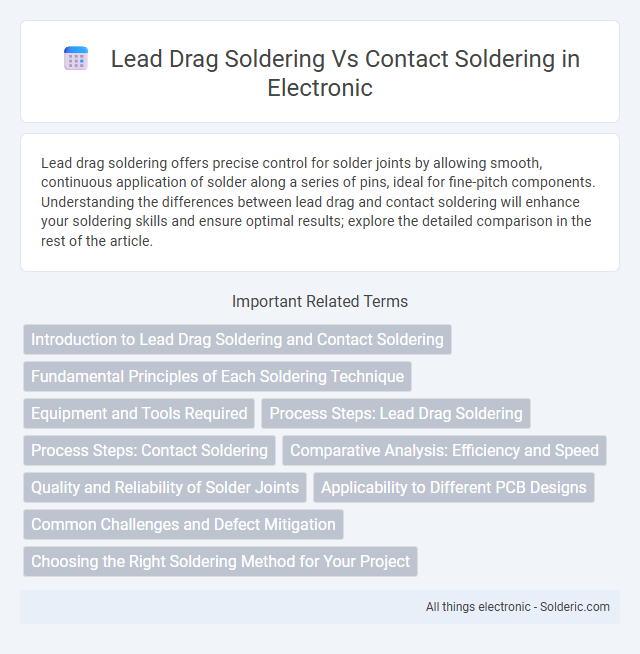Lead drag soldering offers precise control for solder joints by allowing smooth, continuous application of solder along a series of pins, ideal for fine-pitch components. Understanding the differences between lead drag and contact soldering will enhance your soldering skills and ensure optimal results; explore the detailed comparison in the rest of the article.
Comparison Table
| Feature | Lead Drag Soldering | Contact Soldering |
|---|---|---|
| Process | Dragging soldering iron tip with solder along the leads | Direct contact of soldering iron tip on component lead and pad simultaneously |
| Application | Ideal for through-hole components with multiple leads | Used for single-lead or point soldering |
| Speed | Faster for multi-lead soldering | Slower for multiple leads |
| Precision | Moderate precision, risk of bridging | High precision, less risk of solder bridging |
| Heat Control | Heat applied continuously as tip drags | Heat localized on one joint at a time |
| Skill Level | Requires experience to avoid solder bridges | Requires steady hand and precision |
| Typical Use Cases | Mass soldering of multi-lead connectors and IC pins | Repair soldering and precision components |
Introduction to Lead Drag Soldering and Contact Soldering
Lead drag soldering involves moving a solder-coated chisel tip along multiple joint leads to create simultaneous solder connections, optimizing speed and consistency in through-hole or surface-mount assembly. Contact soldering uses a heated tip applied directly to individual solder joints, providing precise control for complex or delicate components. Both methods are essential in electronics manufacturing, with lead drag soldering favored for volume efficiency and contact soldering preferred for detailed or repair work.
Fundamental Principles of Each Soldering Technique
Lead drag soldering involves moving a soldering iron tip along closely spaced leads, allowing molten solder to flow and form secure connections by capillary action. Contact soldering relies on a stationary touch between the soldering iron and the joint, transferring heat directly to melt solder and create the bond. Your choice between these techniques depends on the component density and desired precision in solder joint formation.
Equipment and Tools Required
Lead drag soldering requires specialized soldering irons with a chisel or knife tip designed to drag molten solder across multiple leads efficiently, along with flux pens for proper wetting of joints. Contact soldering employs a heated contact tool or soldering head to simultaneously solder multiple pins by pressing the component leads against the heated surface, often necessitating custom fixtures or jigs for precise alignment. Both methods rely on temperature-controlled soldering stations and appropriate solder wire, but lead drag soldering emphasizes tip design while contact soldering depends on uniform heat distribution and mechanical setup.
Process Steps: Lead Drag Soldering
Lead drag soldering involves positioning the soldering iron at the start of the lead chain, applying flux to ensure proper wetting, and then steadily dragging the soldering iron along the component leads to create consistent solder joints. The process requires maintaining a controlled temperature of the soldering iron, typically between 350degC to 400degC, to avoid thermal damage while ensuring efficient melting of the solder. Precise alignment and smooth movement are essential to achieve uniform solder fillets and prevent bridging or cold joints.
Process Steps: Contact Soldering
Contact soldering involves direct application of a heated soldering iron tip to the joint, melting the solder and creating a strong electrical and mechanical connection. The process steps include cleaning the components and PCB pads, heating the joint with the soldering iron, applying solder wire to the heated area, and then removing both the solder and iron to allow solidification. This method ensures precise control of heat application and solder flow, reducing the risk of thermal damage to sensitive electronic components.
Comparative Analysis: Efficiency and Speed
Lead drag soldering demonstrates higher efficiency and speed due to its ability to solder multiple joints simultaneously by dragging a solder-coated tip across connections. Contact soldering, in contrast, addresses one joint at a time, resulting in slower throughput and increased cycle times. The simultaneous action in lead drag soldering reduces heat exposure and improves production rates, making it preferable for high-volume manufacturing environments.
Quality and Reliability of Solder Joints
Lead drag soldering generally produces consistent solder joints with good wetting and minimal defects, ensuring high mechanical strength and electrical conductivity. Contact soldering can sometimes result in uneven heat distribution, which may cause cold joints or insufficient solder flow, potentially compromising joint reliability over time. Quality and reliability are typically higher in lead drag soldering due to controlled heat application and precise solder placement.
Applicability to Different PCB Designs
Lead drag soldering offers precise control suitable for high-density PCB designs with fine-pitch components, enabling efficient soldering on complex layouts without bridging. Contact soldering excels in simpler PCB configurations and through-hole technology, providing robust solder joints on larger pads but may face challenges on tightly packed surface-mount devices. Optimal PCB design compatibility depends on component density and pad accessibility, where lead drag soldering is preferred for intricate surface-mount assemblies and contact soldering suits conventional, wider-spaced board layouts.
Common Challenges and Defect Mitigation
Lead drag soldering and contact soldering commonly face challenges like solder bridging, cold joints, and insufficient wetting due to inadequate temperature control or improper solder application. Defect mitigation involves precise temperature regulation, proper flux selection, and controlled solder feed rates to ensure reliable joint formation. Your soldering process can be significantly improved by implementing real-time monitoring and adopting best practices tailored to each technique's thermal and mechanical requirements.
Choosing the Right Soldering Method for Your Project
Lead drag soldering offers precise control for complex circuit boards with dense components, making it ideal for projects requiring high accuracy and heat-sensitive elements. Contact soldering provides faster, more robust joints suited for larger components or mass production where efficiency is critical. Your choice depends on project scale, component type, and desired soldering quality.
Lead drag soldering vs contact soldering Infographic

 solderic.com
solderic.com